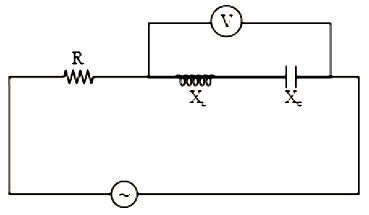The voltage reading on the voltmeter \(V\) in the circuit shown below will be:

| 1. | zero | 2. | \(100\) V |
| 3. | \(200\) V | 4. | \(300\) V |
In a step-up transformer, the turn ratio is 1:2. A Leclanche cell (e.m.f. 1.5V) is connected across the primary coil. The voltage developed in the secondary coil would be-
1. 3.0 V
2. 0.75 V
3. 1.5 V
4. Zero
A \(220~\text{V}, 50~\text{Hz}\) AC source is connected to an inductance of \(0.2~\text{H}\) and a resistance of \(20~\Omega\) in series. What is the current in the circuit:
1. \(10~\text{A}\)
2. \(5~\text{A}\)
3. \(33.3~\text{A}\)
4. \(3.33~\text{A}\)
When the speed of a dc motor increases the armature current
1. Increases
2. Decreases
3. Does not change
4. Increases and decreases continuously
An electric motor operating on a 60 V dc supply draws a current of 10 A. If the efficiency of the motor is 50%, the resistance of its winding is
1. 3Ω
2. 6Ω
3. 15Ω
4. 30Ω
The potential difference V and the current i flowing through an instrument in an ac circuit of frequency f are given by volts and I = 2 sin ωt amperes (where ω = 2πf). The power dissipated in the instrument is
1. Zero
2. 10 W
3. 5 W
4. 2.5 W
In an ac circuit, V and I are given by V = 100 sin (100 t) volts, . The power dissipated in circuit is
1. 104 watt
2. 10 watt
3. 2.5 watt
4. 5 watt
The impedance of a coil, when DC supply is replaced by AC supply:
1. will remain the same
2. will increase
3. will decrease
4. will be zero
A generator produces a voltage that is given by V = 240 sin 120 t, where t is in seconds. The frequency and r.m.s. voltage are
1. 60 Hz and 240 V
2. 19 Hz and 120 V
3. 19 Hz and 170 V
4. 754 Hz and 70 V








